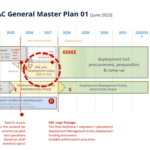Without digital automatic coupling (DAC) there is no digitalisation and without digitalisation there is no competitiveness. This is how the modernisation of the rail freight sector could be described. However, it’s not quite that simple. Here is an overview of the status quo and the next steps to be taken.
This is what it’s all about:
- Combining hardware and software in a targeted manner
- Financing must provide the initial spark
- «Management Deployment DAK-CH» coordinates the migration
- Test phase: Switzerland at the forefront
Combining hardware and software in a targeted manner
The DAK gets the comprehensive digitalisation of the railway rolling. This is because it offers more than just fully automatic coupling or various tracking functions for individual wagons. It enables a leap forward in Swiss rail freight transport by supplying power and data to the entire train. But that’s not all. Data ecosystems are also required for digitally inspired business models in rail freight transport. The state mobility data infrastructure «MODI» is setting a good example here (see blog post «Data ecosystems: Sharing data to double its added value»). In order to combine hardware and software in such a way that the rail freight sector becomes competitive in multimodal logistics, high initial investments are required. Private companies in the freight transport sector will not be able to bear this alone.
Funding must provide the initial impetus
In Switzerland, the Federal Council adopts its dispatch on freight transport in January 2024 and forwards it to Parliament. A central component of this bill is the funding for migration to the DAK. The Federal Council envisages a funding contribution of CHF 180 million. The calculated investment volume for nationwide DAC migration in Switzerland amounts to CHF 500 million. We at the VAP are taking a leading role in the planning of financial resources. The federal government wants to finance the MODI data ecosystem for the first 10 years and then charge user fees. The European Union (EU) has also yet to fund DAC migration. The EU Commission intends to provide around EUR 200 million for the planned field tests from 2026.
«Management Deployment DAK-CH» coordinates the migration
The cross-industry committee «Management Deployment DAK-CH» will be responsible for coordinating the migration implementation in Switzerland. Among other things, this committee is responsible for the active exchange with Europe’s Rail, the planning of workshop capacities, the material disposition and the verification of the conversions. It must schedule the conversion of the vehicles in advance together with the keepers, as well as with the railway companies and other logistics players. In the meantime, the rail freight companies should determine their requirements for converted wagons according to the volume of traffic.
Test phase: Switzerland at the forefront
The functions and processes of the DAK must be harmonised throughout Europe. One milestone is the definition of the «Starter Package». This defines which functions the DAK migration will start with in Europe. Switzerland is currently actively involved in operational tests of new systems and is contributing pioneering results to the European working groups. Here is an overview of the current tests and projects with Swiss participation:
- The EU is having the rail technology specifications drawn up for the implementation of the «Greening Freight Traffic Package» of the European DAC Delivery Programme (EDDP). Switzerland is actively involved here.
- With «Power-Line-Plus», data is sent via the power supply lines. The Lucerne University of Applied Sciences and Arts is conducting operational tests together with SBB Cargo and providing key insights into data transmission quality. From 2024, proof of operational suitability is to be provided with all the functions of the «Starter Package» and transmission via «Power-Line-Plus», making commercial journeys possible. The FOT is supporting this development financially.
- From 2026, extensive field tests for the operational suitability and reliability of the DAK are planned in Europe with around 100 trains. After that, the aim is to migrate DAK efficiently, including in Switzerland.
- MODI consists of two main elements: The National Data Networking Infrastructure Mobility (NADIM) enables the standardised exchange of mobility data. The national geodata infrastructure «Transport Network CH» can ensure a standardised, digital representation of Switzerland’s entire transport system. MODI is currently only intended for passenger transport. However, freight transport could also benefit from this, for example through the digital networking of public authorities, transport and spatial planning authorities and all stakeholders involved. For this reason, the VAP is in close contact with the responsible offices of the federal administration in order to quickly integrate freight transport into the project.

